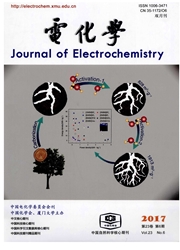

 中文摘要:
中文摘要:
应用电位扫描法将Pd(Ⅱ)离子沉积到玻碳电极表面,形成纳米结构的金属钯薄膜电极.然后在酸性溶液中控制适当的阴极电位,使该薄膜电极的钯吸收足量的活性氢,进而以吸收的氢作还原剂将Au(Ⅲ)离子还原,制得Au-Pd双金属薄膜电极.扫描电镜、循环伏安法等测试表明,该电极Au-Pd沉积层对乙醇的氧化具有很高的电催化活性.
 英文摘要:
英文摘要:
The nanostructured Pd thin films were directly formed on the glassy carbon electrode (GCE) substrates by using potential cycling method. The as-prepared Pd thin films deposited onto the GCE were able to absorb enough amount of hydrogen in acidic solutions at the cathodic potentials more negative than the hydrogen evolution potential. Moreover, the absorbed hydrogen could be used as the reducing agent to reduce gold(Ⅲ) ions to Au nanoclusters, thereby forming bimetallic Au-Pd thin films on the GCE substrate. SEM and cyclic voltammetry characterization demonstrated that the Au-Pd thin films display much higher catalytic activity towards the electro-oxidation of ethanol than the pure Pd thin films.
 同期刊论文项目
同期刊论文项目
 同项目期刊论文
同项目期刊论文
 Electrocatalytic oxidation of D-glucose at nanoporous Au and Au-Ag alloy electrodes in alkaline aque
Electrocatalytic oxidation of D-glucose at nanoporous Au and Au-Ag alloy electrodes in alkaline aque Fabrication of Gold Nanoprism Thin Films and Their Applications in Designing High Activity Electroca
Fabrication of Gold Nanoprism Thin Films and Their Applications in Designing High Activity Electroca Facile fabrication and unexpected electrocatalytic activity of palladium thin films with hierarchica
Facile fabrication and unexpected electrocatalytic activity of palladium thin films with hierarchica 期刊信息
期刊信息
